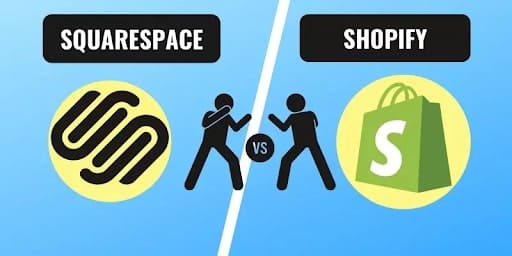Comparing Shopify and Squarespace might initially seem odd, as they serve different purposes. Shopify primarily focuses on ecommerce, while Squarespace provides a more versatile website design solution. However, several key factors come into play when deciding between the two platforms. Evaluating their core features, aligning your goals with your budget, considering marketing potential, and assessing ecommerce capabilities are essential steps in making the right choice. In this in-depth analysis of Shopify vs Squarespace, we will delve into various aspects, starting with their overall feature sets. We'll also explore their search engine optimization (SEO) functionalities and pricing models. Additionally, we will address their strengths in ecommerce capabilities and examine their respective user interfaces (UI) to help you make an informed decision for your online store or website. By thoroughly understanding the strengths and weaknesses of both Shopify and Squarespace, you'll be better equipped to choose the platform that aligns with your specific needs and maximizes your chances of success.
Shopify vs. Squarespace. The Basics
With over 2 billion people engaging in online shopping daily, having an e-commerce store has become crucial for most businesses. The process might initially seem daunting, requiring appealing design, easy navigation, and SEO adjustments to attract your target audience. However, now there are user-friendly one-stop shop platforms that enable you to build your e-commerce site without any coding knowledge. Shopify and Squarespace are prominent players in this field, each offering unique approaches. Squarespace is renowned as a website builder, while Shopify provides a comprehensive platform to facilitate online selling. In this guide, we will explore the advantages and disadvantages of both platforms to help you determine which one suits your needs best.
Key Similarities and Differences
While Shopify and Squarespace may appear similar initially, they were designed with distinct target audiences in mind. Shopify caters to retailers seeking higher sales volumes, offering robust support through its app marketplace. Originating in 2006 with a group of friends in Canada who struggled to sell their goods online, Shopify has since grown exponentially, powering over 4.4 million websites in over 175 countries. In contrast, Squarespace excels at providing many attractive templates to enhance your web presence. It is well-suited for assisting businesses in building their brand and engaging with customers online. Squarespace started as a content publisher in 2004 and has recently expanded into e-commerce functionalities, empowering over 2.96 million websites.Ease of Use
Both Shopify and Squarespace offer excellent user experiences regarding ease of use, but one platform stands out with its intuitive design and rapid setup. Shopify allows you to launch your web store within minutes, even without experience building e-commerce shops. The intuitive dashboard presents all essential shortcuts just a click away, and the drag-and-drop functionality enables easy customization of your store's layout. Visual cues aid in theme selection and make adding items to your store a seamless process. Squarespace might have a steeper learning curve for newcomers, particularly with its built-in business tools. However, its drag-and-drop functionality is intuitive, facilitating a quick setup, especially with abundant available templates. Squarespace pays careful attention to visual cues, making certain aspects more challenging than its competitor. In summary, Shopify offers a more user-friendly experience, but Squarespace's system becomes navigable with some familiarity. Ultimately, the choice between Shopify and Squarespace will depend on your specific requirements and preferences, but both platforms are equipped to help you embark on a successful e-commerce journey.Pricing
Regarding pricing, both e-commerce giants offer various options tailored to different business needs. Shopify's pricing starts at $32 per month and goes up to $399 monthly for the Shopify Advanced plan. On the other hand, Squarespace offers plans ranging from $23 to $65 per month, with discounts available for yearly payments. For beginners, the basic plans are suitable, but businesses with higher sales volumes may consider upgrading. Both platforms entice users to opt for higher-paid plans with added benefits. Shopify provides more insightful reports, additional staff accounts, and lower transaction fees for premium plans. Squarespace offers most of its advanced features under the "Business plan," excluding e-commerce capabilities in the basic plan.Features
In terms of features, both platforms offer a plethora of options. However, we'll focus on critical elements for a business's online presence. Both Shopify and Squarespace support the sale of digital and physical products, as well as services. Squarespace provides built-in support for selling digital products, while Shopify requires additional apps for the same functionality. Product presentation is vital, and both platforms excel in this area. Squarespace stands out with its ready-to-use zoom feature and the ability to turn photos into 360-degree videos, giving customers a more immersive view. Shopify also offers a zoom function through apps, ensuring an impressive product presentation. Regarding payment options, Shopify takes the lead, supporting almost all major payment gateways, cryptocurrencies, and various payment methods. Squarespace offers limited payment options like PayPal, Stripe, and Apple Pay, with physical POS integration available only in the US. Shopify offers more comprehensive options for shipping physical products with built-in integration with UPS and printable labels. Squarespace is catching up in this aspect but still has room for improvement to compete effectively with Shopify. In the realm of marketing features, Shopify provides more complex tools, including SEO, email campaigns, and social media integration. Squarespace shines in blogging capabilities. Shopify's advantages in marketing stem from its vast array of app choices that simplify marketing efforts for businesses. In conclusion, both platforms offer unique strengths and cater to different business needs. Carefully assessing your requirements and goals will help you decide whether Shopify or Squarespace fits your online store.


